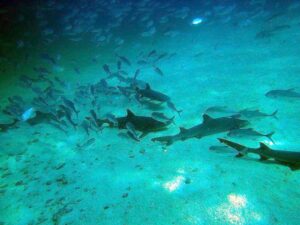
Let’s dive into the fascinating world of the Whitetip Reef Shark—a sleek and agile swimmer that graces the coral reefs of Coiba National Park in the Eastern Pacific Corridor.
The Whitetip Reef Shark: A Coral Reef Enthusiast
- Introduction
The Triaenodon obesus, commonly known as the Whitetip Reef Shark, is a true icon of tropical coral reefs. Its slender body and characteristic white-tipped fins make it instantly recognizable. Let’s explore its habitat, behavior, and unique features.
- Habitat and DistributionDiving with sharks in Coiba Panama
- Range: Whitetip reef sharks are widespread throughout the tropical Indian Ocean and the west/central Pacific. However, their presence in the Eastern Pacific is more limited to The Tropical Eastern Pacific but the animals can be larger than their Indo Pacific cousins.
- Eastern Pacific Range: In the Eastern Pacific, you’ll find them from Costa Rica to Panama and even around the Galápagos Islands.
- Preferred Haunts: These sharks are coral enthusiasts, often frequenting coral heads, ledges with high vertical relief, and sandy flats. They’re equally at home in lagoons and near drop-offs to deeper waters.
- Behavior and Adaptations
- Nocturnal Explorers: Whitetip reef sharks are primarily nocturnal. They emerge from their daytime hiding spots to hunt at night.
- Cave Dwellers: Their slender bodies allow them to maneuver gracefully through caves and crevices, seeking shelter during daylight hours.
- Social Creatures: These sharks are often seen in small groups, resting together in cozy nooks on the reef. But when thermoclines arrive they aggregate in groups of several dozens in shallower reefs where the temperature does not fall below 25 degrees Celsius.
- Agile Swimmers: Their streamlined form makes them agile swimmers, perfect for navigating the intricate coral structures. Studies around Coiba show, that they are not limited to small areas, but can travel several kilometers.

- Unique Features
- White-Tipped Fins: As the name suggests, their dorsal and caudal fins have striking white tips. These markings are not only beautiful but also serve as a visual identifier.
- Camouflage Masters: Their mottled gray-brown coloration helps them blend seamlessly into the reef background.
- Relatively Small Size: Whitetip reef sharks typically grow to about 5 to 6 feet in length, making them manageable companions for divers.
- Conservation Status
- Common but Vulnerable: While they are common, their populations face threats due to overfishing, habitat degradation, and climate change.
- Advocacy and Awareness: Scuba diving businesses that specialize in shark encounters play a crucial role in raising awareness about these magnificent creatures and promoting responsible diving practices.
- Dive Safely with Whitetip Reef Sharks
- Diving with us, we ask to respect the animals, not to harras or feed them.
- Respect Their Space: Maintain a respectful distance and avoid touching or disturbing them.
- Capture Memories: Bring your underwater camera to capture the magic of encountering a Whitetip Reef Shark.
In our next blog, we’ll explore another captivating shark species. Until then, keep your fins ready and your sense of wonder alive! 🦈🌊
References:
- Oceana – Whitetip Reef Shark
- Aquarium of the Pacific – Whitetip Reef Shark
- Sharkwater – White-tip Reef Shark
